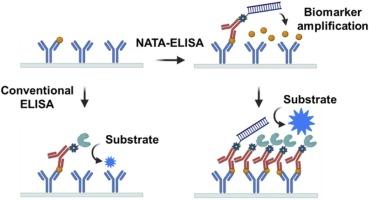利用生物标记原位扩增技术重新审视 ELISA,以提高其灵敏度
IF 8
1区 化学
Q1 CHEMISTRY, ANALYTICAL
引用次数: 0
摘要
酶联免疫吸附试验(ELISA)是诊断和生物医学研究领域的关键仪器,广泛用于检测和量化与疾病相关的特定蛋白质。尽管酶联免疫吸附测定法发挥着关键作用,但其识别低浓度蛋白质的能力仍然是一个重大挑战,阻碍了它在早期诊断领域的有效性,而这一领域的重要性与日俱增。本研究引入了一种称为核酸模板扩增(NATA)的新方法,以提高 ELISA 的灵敏度,而无需对目前 ELISA 的常见做法进行重大修改。我们的方法从病毒增殖机制中汲取灵感,利用编码目标生物标记物的 DNA 序列整合了无细胞蛋白质合成步骤。这种方法能在 ELISA 检测过程中原位 "放大 "目标蛋白质,将其浓度提高到可检测的水平。我们的研究结果表明,ELISA 的灵敏度大大提高,现在可以检测到微摩尔浓度的蛋白质生物标记物--接近核酸分析中通常用于 PCR 的灵敏度范围。这一突破不仅拓宽了 ELISA 在早期疾病诊断和治疗干预监测方面的应用范围,而且标志着蛋白质生物标记物检测技术的重大进步。我们的方法采用模块化设计,具有很高的通用性和灵敏度,为临床诊断和研究中的蛋白质检测提供了一种先进的方法。本文章由计算机程序翻译,如有差异,请以英文原文为准。

Revisiting ELISA with in situ amplification of biomarkers to boost its sensitivity
The enzyme-linked immunosorbent assay (ELISA) stands as a pivotal instrument in diagnostics and biomedical research, widely used for the detection and quantification of specific proteins associated with diseases. Despite its critical role, ELISA's ability to identify low-concentration proteins remains a significant challenge, hindering its effectiveness in early diagnostics, an area of growing importance. This study introduces a novel approach termed nucleic acid-templated amplification (NATA) to enhance ELISA's sensitivity without significantly modifying the common practices of the present ELISA. Drawing inspiration from viral proliferation mechanisms, our approach integrates a cell-free protein synthesis step using DNA sequences that encode the target biomarkers. This approach enables an in situ 'amplification' of target proteins during ELISA, boosting their concentrations to detectable levels. Our results demonstrate a substantial enhancement in sensitivity, with ELISA now being able to detect protein biomarkers at femtomolar concentrations—approaching the sensitivity range typically reserved for PCR in nucleic acid analysis. This breakthrough not only broadens ELISA’s applicability in early disease diagnosis and monitoring therapeutic interventions but also marks a significant advancement in protein biomarker detection technology. With its modular design, our method also offers high versatility and sensitivity, offering an advanced approach for protein detection in clinical diagnostics and research.
求助全文
通过发布文献求助,成功后即可免费获取论文全文。
去求助
来源期刊

Sensors and Actuators B: Chemical
工程技术-电化学
CiteScore
14.60
自引率
11.90%
发文量
1776
审稿时长
3.2 months
期刊介绍:
Sensors & Actuators, B: Chemical is an international journal focused on the research and development of chemical transducers. It covers chemical sensors and biosensors, chemical actuators, and analytical microsystems. The journal is interdisciplinary, aiming to publish original works showcasing substantial advancements beyond the current state of the art in these fields, with practical applicability to solving meaningful analytical problems. Review articles are accepted by invitation from an Editor of the journal.
 求助内容:
求助内容: 应助结果提醒方式:
应助结果提醒方式:


